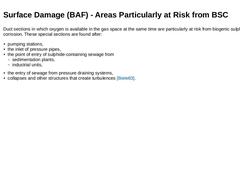
|
Duct sections in which oxygen is available in the gas space at the same time are particularly at risk from biogenic sulphuric acid corrosion. These special sections are found after: -
pumping stations,
-
the inlet of pressure pipes,
-
the point of entry of sulphide-containing sewage from
-
sedimentation plants,
-
industrial units,
-
the entry of sewage from pressure draining systems,
-
collapses and other structures that create turbulences [Biele83].
|
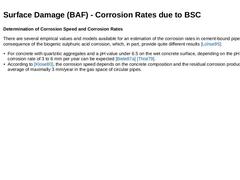
|
Determination of Corrosion Speed and Corrosion Rates There are several empirical values and models available for an estimation of the corrosion rates in cement-bound pipes as a consequence of the biogenic sulphuric acid corrosion, which, in part, provide quite different results [Lohse95]: -
For concrete with quartzitic aggregates and a pH value under 6.5 on the wet concrete surface, depending on the pH value, a corrosion rate of 3 to 6 mm per year …
|
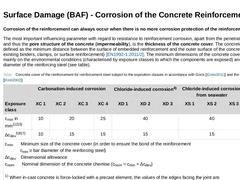
|
Corrosion of the reinforcement can always occur when there is no more corrosion protection of the reinforcement. The most important influencing parameter with regard to resistance to reinforcement corrosion, apart from the penetration resistance and thus the pore structure of the concrete (impermeability), is the thickness of the concrete cover. The concrete cover is defined as the minimum distance between the surface of embedded reinforcement and … |
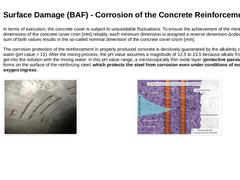
|
In terms of execution, the concrete cover is subject to unavoidable fluctuations. To ensure the achievement of the minimum dimensions of the concrete cover cmin [mm] reliably, each minimum dimension is assigned a reserve dimension ∆cdev [mm]. The sum of both values results in the so-called nominal dimension of the concrete cover cnom [mm]. The corrosion protection of the reinforcement in properly produced concrete is decisively guaranteed by the alkalinity … |
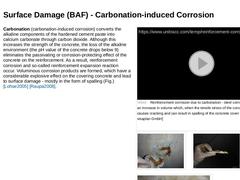
|
Carbonation (carbonation-induced corrosion) converts the alkaline components of the hardened cement paste into calcium carbonate through carbon dioxide. Although this increases the strength of the concrete, the loss of the alkaline environment (the pH value of the concrete drops below 9) eliminates the passivating or corrosion-protecting effect of the concrete on the reinforcement. As a result, reinforcement corrosion and so-called reinforcement … |
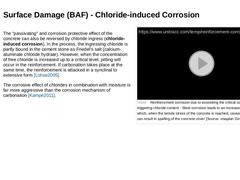
|
The “passivating” and corrosion protective effect of the concrete can also be reversed by chloride ingress (chloride-induced corrosion). In the process, the ingressing chloride is partly bound in the cement stone as Friedel's salt (calcium-aluminate chloride hydrate). However, when the concentration of free chloride is increased up to a critical level, pitting will occur in the reinforcement. If carbonation takes place at the same time, the reinforcement … |
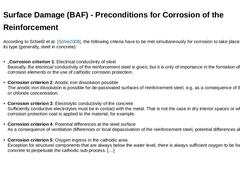
|
According to Schießl et al. [Schie2008], the following criteria have to be met simultaneously for corrosion to take place, regardless of its type (generally, steel in concrete):
-
„Corrosion criterion 1: Electrical conductivity of steel
Basically, the electrical conductivity of the reinforcement steel is given, but it is only of importance in the formation of macro corrosion elements or the use of cathodic corrosion protection.
-
Corrosion criterion …
|
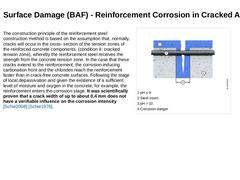
|
The construction principle of the reinforcement steel construction method is based on the assumption that, normally, cracks will occur in the cross- section of the tension zones of the reinforced concrete components (condition II: cracked tension zone), whereby the reinforcement steel receives the strength from the concrete tension zone. In the case that these cracks extend to the reinforcement, the corrosion-inducing carbonation front and the chlorides … |
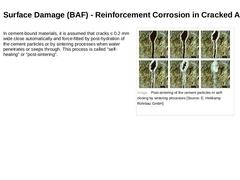
|
In cement-bound materials, it is assumed that cracks ≤ 0.2 mm wide close automatically and force-fitted by post-hydration of the cement particles or by sintering processes when water penetrates or seeps through. This process is called "self-healing" or "post-sintering". (Image: Post-sintering of the cement particles or self-closing by sintering processes ) |
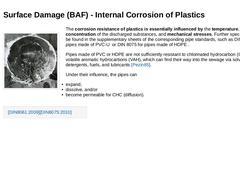
|
(Image: Corrosion of a GRP sewer by methyl chloride) The corrosion resistance of plastics is essentially influenced by the temperature, concentration of the discharged substances, and mechanical stresses. Further specifications can be found in the supplementary sheets of the corresponding pipe standards, such as DIN 8061 for pipes made of PVC-U or DIN 8075 for pipes made of HDPE . Pipes made of PVC or HDPE are not sufficiently resistant to chlorinated … |
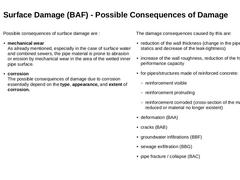
|
Possible consequences of surface damage are : -
mechanical wear
As already mentioned, especially in the case of surface water and combined sewers, the pipe material is prone to abrasion or erosion by mechanical wear in the area of the wetted inner pipe surface.
-
corrosion
The possible consequences of damage due to corrosion essentially depend on the type, appearance, and extent of corrosion.
The damage consequences caused by this are: |
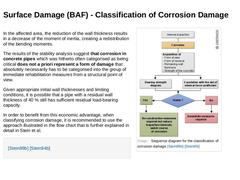
|
In the affected area, the reduction of the wall thickness results in a decrease of the moment of inertia, creating a redistribution of the bending moments. The results of the stability analysis suggest that corrosion in concrete pipes which was hitherto often categorised as being critical does not a priori represent a form of damage that absolutely necessarily has to be categorised into the group of immediate rehabilitation measures from a structural … |
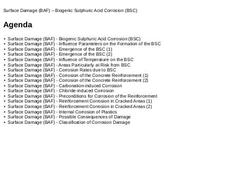
|
|
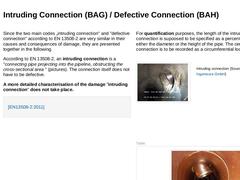
|
Since the two main codes „intruding connection" and "defective connection" according to EN 13508-2 are very similar in their causes and consequences of damage, they are presented together in the following. According to EN 13508-2, an intruding connection is a "connecting pipe projecting into the pipeline, obstructing the cross-sectional area " (pictures). The connection itself does not have to be defective. A more detailed characterisation of the damage |
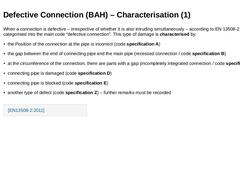
|
When a connection is defective – irrespective of whether it is also intruding simultaneously – according to EN 13508-2, it is categorised into the main code “defective connection”. This type of damage is characterised by: -
the Position of the connection at the pipe is incorrect (code specification A)
-
the gap between the end of connecting pipe and the main pipe (recessed connection / code specification B)
-
at the circumference of the connection, there …
|
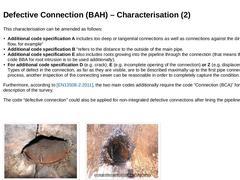
|
This characterisation can be amended as follows: -
Additional code specification A includes too deep or tangential connections as well as connections against the direction of the flow, for example”
-
Additional code specification B “refers to the distance to the outside of the main pipe.
-
Additional code specification E also includes roots growing into the pipeline through the connection (that means that the main code BBA for root intrusion is to be …
|
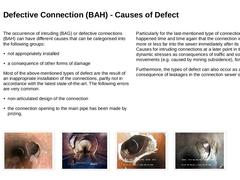
|
The occurrence of intruding (BAG) or defective connections (BAH) can have different causes that can be categorised into the following groups: Most of the above-mentioned types of defect are the result of an inappropriate installation of the connections, partly not in accordance with the latest state-of-the-art. The following errors are very common: |
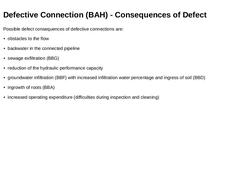
|
Possible defect consequences of defective connections are: -
obstacles to the flow
-
backwater in the connected pipeline
-
sewage exfiltration (BBG)
-
reduction of the hydraulic performance capacity
-
groundwater infiltration (BBF) with increased infiltration water percentage and ingress of soil (BBD)
-
ingrowth of roots (BBA)
-
increased operating expenditure (difficulties during inspection and cleaning)
|
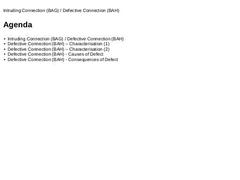
|
|
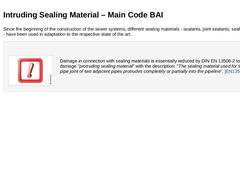
|
Since the beginning of the construction of the sewer systems, different sealing materials - sealants, joint sealants, sealing rings, etc. - have been used in adaptation to the respective state of the art. Important: Damage in connection with sealing materials is essentially reduced by DIN EN 13508-2 to the damage "protruding sealing material" with the description: "The sealing material used for sealing a pipe joint of two adjacent pipes protrudes … |
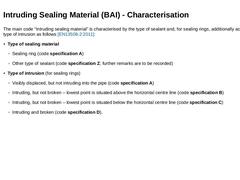
|
The main code “Intruding sealing material” is characterised by the type of sealant and, for sealing rings, additionally according to the type of intrusion as follows [EN13508-2:2011]: |
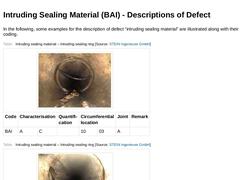
|
In the following, some examples for the description of defect “intruding sealing material” are illustrated along with their respective coding. (Table: Intruding sealing material – Intruding sealing ring) (Table: Intruding sealing material – Intruding sealing ring) (Table: Intruding sealing material – Intruding and broken sealing ring) (Table: Intruding sealing material – Intruding sealing ring with root ingrowth) According to EN 13508-2, the occurring |
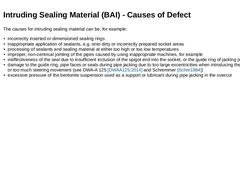
|
The causes for intruding sealing material can be, for example: -
incorrectly inserted or dimensioned sealing rings
-
inappropriate application of sealants, e.g. onto dirty or incorrectly prepared socket areas
-
processing of sealants and sealing material at either too high or too low temperatures
-
improper, non-centrical jointing of the pipes caused by using inappropriate machines, for example
-
ineffectiveness of the seal due to insufficient inclusion …
|
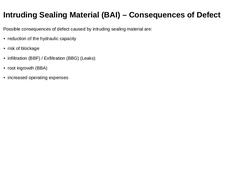
|
Possible consequences of defect caused by intruding sealing material are: -
reduction of the hydraulic capacity
-
risk of blockage
-
infiltration (BBF) / Exfiltration (BBG) (Leaks)
-
root ingrowth (BBA)
-
increased operating expenses
|
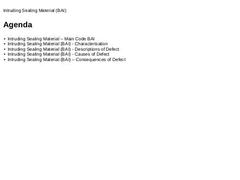
|
|